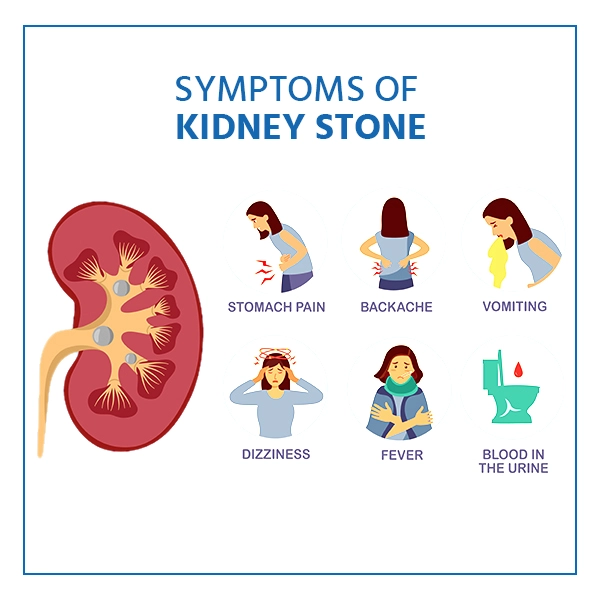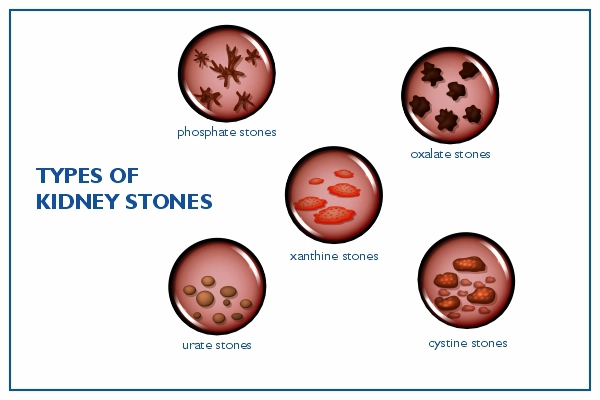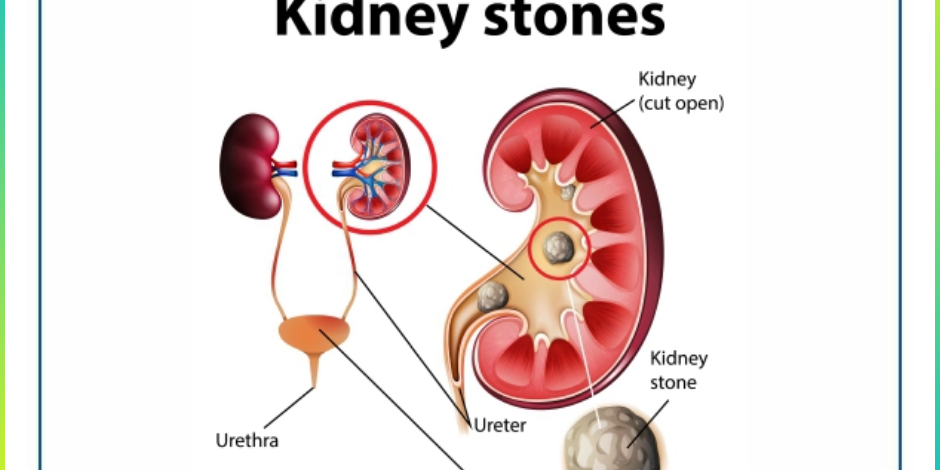Kidney stones (renal calculi, urolithiasis, or nephrolithiasis) are hard masses, deposits of minerals and salts that form inside the kidneys.
The size of kidney stones are usually like a chickpea, but they can also be as small as a grain of sand grain or as large as a golf ball. However, small stones can pass through the urinary tract, but larger ones may require surgery.
Kidney stones can be caused by a variety of factors, including diet, excess body weight, certain medical conditions, and certain supplements and medications. The stones can affect any part of your urinary tract, including the kidneys and bladder.
Symptoms of Kidney Stones
A kidney stone normally does not cause symptoms until it moves around within the kidney or goes through the ureters, which connect the kidneys and bladder. It can block the flow of urine and cause the kidney to enlarge and the ureter to spasm, which can be quite painful. You may then experience the following signs and kidney stones symptoms:
Other signs and symptoms may include:
- Pain in the side and back, below the ribcage, is severe and intense
- Pain in the lower abdomen and groin that radiates
- Urinating causes pain or a burning sensation.
- Blood in the urine
- Frequent urge to urinate
- Urinating in small amounts
- Nausea
- Fever and chills

As a kidney stone passes through the urinary tract, the pain it causes may vary — for example, migrating to a new spot or rising in intensity.
Types of Kidney Stones
Knowing the type of kidney stone can help to determine its cause and may provide guidance on how to lower your risk of future kidney stones. If possible, save the kidney stone and bring it to the doctor for analysis.
- Calcium stones : The majority of kidney stones are calcium stones, most of which are calcium oxalate. Oxalate is a chemical that the liver produces or that people consume through their diet. Oxalate levels are high in several fruits and vegetables, as well as nuts and chocolate.

- Struvite stones : These are developed as a result of a urinary tract infection. These stones can develop rapidly and become quite large, with minimal signs or warning.
- Uric acid stones : People who consume high-protein diets, have diabetes or metabolic syndrome and also who lose too much fluid due to chronic diarrhea or malabsorption, are at risk of developing uric acid stones. Certain genetic factors may also enhance your chances of developing uric acid stones.
- Cystine stones : These stones are formed in people who have cystinuria, a hereditary condition in which the kidneys discharge an excessive amount of certain amino acids.
Causes
There is no known cause for a kidney stone. However, certain conditions may increase the chances of developing this disorder. Kidney stones can form when the urine includes more crystal-forming components, including calcium, oxalate, and uric acid, than the fluid in the urine. Sometimes the urine lacks chemicals that help in preventing the crystals from adhering together and forming kidney stones
Risk factors
Factors that increase the risk of developing kidney stones include:
- Dehydration : Not drinking enough water can raise the risk of kidney stones. People who live in hot, dry regions or who sweat a lot may be at a higher risk than others.
- Obesity : A high BMI, a large waist circumference, and weight gain have all been associated to an increased risk of kidney stones.
- Digestive diseases and surgery : Changes in the digestive process caused by inflammatory bowel disease or gastric bypass surgery might impair calcium and water absorption, increasing the amount of stone-forming chemicals in the urine
How is Kidney Stones diagnosed?
- Blood testing : Blood tests may identify an excess of calcium or uric acid in your blood. Blood test results help your doctor monitor the health of your kidneys and may lead him or her to examine for other medical concerns.
- Urine testing : In this test, the urine is tested, which is collected 24-hour. This could indicate that the individual is excreting either too many stone-forming minerals or not enough stone-preventing chemicals. The doctor may recommend collecting two urine samples on two consecutive days for this test
- Imaging : Urine imaging tests may reveal kidney stones. Even microscopic stones can be detected using high-speed or dual-energy computerized tomography (CT). Simple abdominal X-rays are less commonly utilized. Another imaging technique for diagnosing kidney stones is ultrasound, which is a noninvasive, rapid and easy test.
Kidney Stone Treatment
Small stones with minimal symptoms Most small kidney stones do not require invasive treatment. The small stone can be passed through:
- Drinking water : Drinking 1.8 to 3.6 liters of water per day will dilute the urine and may prevent stones from developing. Unless otherwise directed by the doctor, drink enough water to create clear or almost clear urine.
- Using sound waves to break up stones : The doctor may recommend extracorporeal shock wave lithotripsy (ESWL) for certain kidney stones. Sound waves are used in ESWL to generate intense vibrations (shock waves) that break the stones into little pieces that can be passed in your urine. The operation takes about 45 to 60 minutes and can be painful, so patients may be medicated or given light anesthesia to make them more comfortable.
- Surgery to remove very large stones in the kidney : Percutaneous nephrolithotomy is a kidney stone surgery that removes the kidney stone using a small telescope that is placed through a small incision in the back.During the procedure, patients will be anesthetized and hospitalized for one to two days to recover. If ESWL does not work, the doctor may recommend this surgery.
- Using a scope to remove stones : To remove a small stone in the ureter or kidney, the doctor may insert a thin tube, known as a ureteroscope equipped with a camera through the urethra and bladder into the ureter.Once the stone has been identified, specific equipment can entrap it or break it up into pieces that will flow through the urine. The doctor may then insert a small tube (stent) into the ureter to reduce swelling and facilitate recovery. This operation may require a general or local anesthetic.

